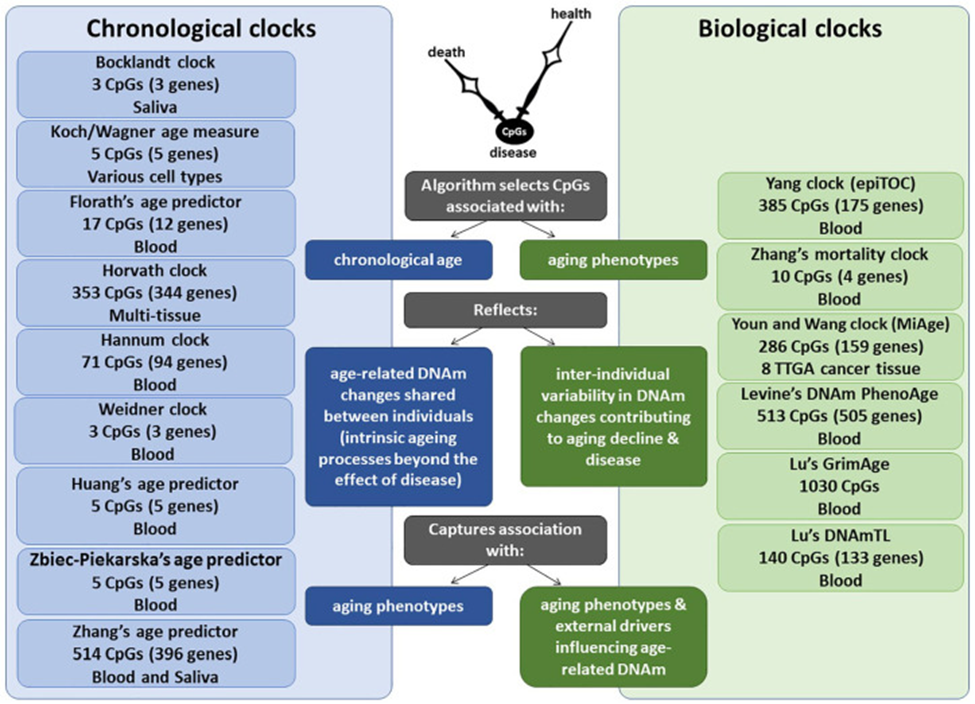Welcome to part 4 of the ODX series on "Biological Age: A True Measure of Health." In the fourth post in our series, we will discuss DNA methylation, one of the methods used to measure biological age.
The ODX Biological Age Series
Dicken Weatherby, N.D. and Beth Ellen DiLuglio, MS, RDN, LDN
- Biological Age - Part 1: What is Biological Age?
- Biological Age - Part 2: How to Measure Biological Age: Overview
- Biological Age - Part 3: How to Measure Biological Age: Key Biomarkers
- Biological Age - Part 4: How to Measure Biological Age: DNA Methylation (DNAm)
- Biological Age - Part 5: How to Measure Biological Age: Telomere Length
- Biological Age - Part 6: How to Improve Biological Age
- Biological Age - Part 7: Optimal Takeaways
Biological age can be further evaluated using an epigenetic biomarker known as DNA methylation (DNAm). Epigenetics reflects how chemical changes alter how genes are expressed and whether they are turned off or on. DNA methylation refers to adding a methyl group to a specific portion of DNA, which usually turns a gene off or removing a methyl group, which turns a gene on. DNAm also reflects how cells are aging; DNAm patterns can be significantly altered with aging and appear to be associated with cancerous changes (Levine, 2023).
However, potential cofounders associated with DNA methylation evaluation and accuracy include genetic factors, environmental factors, and variations in specific DNAm arrays (Bergsma 2020).
Comparison of chronological vs biological DNAm clocks.

Each DNAm clock is developed using a unique training model, including a variable number of CpGs, tissue source of DNA and corresponding age-related measures. While chronological DNAm clocks reflect age-related DNAm changes that are shared between individuals and are expected to reflect the intrinsic aging process, biological DNAm clocks reflect age-related DNAm changes that vary between individuals and are expected to capture associations with specific age-related phenotypes and external drivers that may influence age-related DNAm.
Source: Bergsma, Tessa, and Ekaterina Rogaeva. “DNA Methylation Clocks and Their Predictive Capacity for Aging Phenotypes and Healthspan.” Neuroscience insights vol. 15 2633105520942221. 21 Jul. 2020, doi:10.1177/2633105520942221 This article is distributed under the terms of the Creative Commons Attribution-NonCommercial 4.0 License
DNAm combined with phenotypic (biological) age calculations yield a DNAm PhenoAge. Ultimately, changes in DNAm PhenoAge were highly correlated with changes in biological age, a more straightforward, more attainable equation. Research indicates that DNAm PhenoAge can help predict aging outcomes, including (Levine 2018):
- All-cause mortality
- Alzheimer's disease.
- Cancers
- Healthspan
- Physical functioning
- Aging at the cell and tissue level
The DNAm PhenoAge was significantly associated with subsequent mortality in 5 large-scale study samples independent of chronological age.
- A one-year increase in DNAm PhenoAge was associated with a 4.5% increase in all-cause mortality risk, increased coexisting morbidities, increased CHD risk, improved physical functioning issues, and decreased disease-free likelihood.
- The DNAm PhenoAge biomarker predicted the risk of lung cancer incidence and mortality in smokers. It was also positively associated with neuropathological hallmarks of Alzheimer’s disease, including amyloid load, neuritic plaques, and neurofibrillary tangles.
- Lower DNAm PhenoAge is associated with more exercise; increased markers of increased fruit and vegetable intake; lower levels of C-reactive protein, insulin, glucose, triglycerides, and waist-to-hip ratio; higher HDL cholesterol; higher education; and higher income, demonstrating a negative association between DNAm PhenoAge and these factors.
- A positive association is observed with a higher DNAm PhenoAge and elevated C-reactive protein, insulin, glucose, triglycerides, waist-to-hip ratio, BMI, blood pressure, and smoking.
- A higher DNAm PhenoAge was also found to correlate weakly with shorter leukocyte telomere length, a marker of aging.
Researchers conclude that increased DNAm PhenoAge, relative to chronological age, is associated with;
- Activation of pro-inflammatory pathways, e.g., NF-kappaB
- Increased interferon signaling, a marker of DNA damage and cellular senescence
- Increased DNA damage and decreased DNA repair
- Transcriptional/translational signaling
- Various markers of immunosenescence
- Decline of naïve T cells
- Shortened leukocyte telomere length
Reference
Bergsma, Tessa, and Ekaterina Rogaeva. “DNA Methylation Clocks and Their Predictive Capacity for Aging Phenotypes and Healthspan.” Neuroscience insights vol. 15 2633105520942221. 21 Jul. 2020, doi:10.1177/2633105520942221
Levine, Morgan E et al. “An epigenetic biomarker of aging for lifespan and healthspan.” Aging vol. 10,4 (2018): 573-591. doi:10.18632/aging.101414
Levine, Morgan. True Age: Cutting-edge Research to Help Turn Back the Clock. Penguin, 2023.







